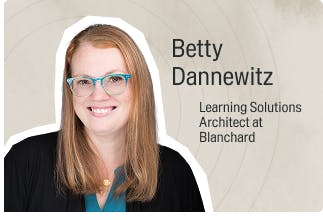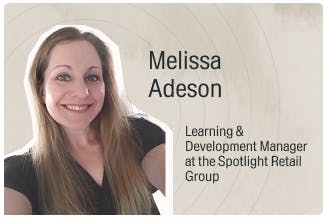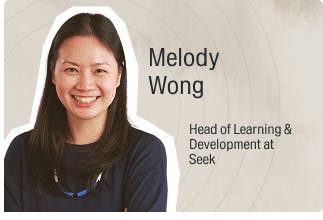Building empathy and trust on teams with Mindscaling’s President and Founder, Shawn Hunter
About the guest
Shawn Hunter is an entrepreneur, speaker, best-selling author of Small Acts of Leadership, and currently Founder and President of Mindscaling, a company dedicated to creating beautiful, and intelligent online learning products.
Until July, 2015 Shawn was Executive Producer & Vice President for Leadership Solutions at Skillsoft. For over a decade Hunter has interviewed, collaborated with, and filmed hundreds of leading business authors, executives, and business school faculty in an effort to assemble video learning solutions. He started this journey as an entrepreneur, and later expanded that business for Skillsoft. Hunter originally co-founded Targeted Learning Corporation with his father Hal Hunter, Ph.D., which was acquired by Skillsoft in February 2007.
Transcript
Dan: Welcome to L&D in 20, your go to resource for all things workplace learning brought to you by Go1. I'm your host, Dan Hayward, Chief Customer Officer and industry veteran.
Today, we'll be speaking with Shawn Hunter, Founder and President of Mindscaling, a company that builds and designs leadership experiences, hand crafting best in class courses. Shawn has over 20 years of experience in designing and building customized learning experiences that create real measurable change within organizations.
He's also a podcaster, a speaker, a writer, and the best-selling author of two books on leadership and innovation, Small Acts of Leadership, And OutThink, Shawn, welcome to the show.
Shawn: Thank you so much. Happy to be here.
Dan: It's great to have you.
Today we're talking about soft skills in the workforce, particularly mental flexibility, collaboration, and creativity in the workplace.
Much of your work is focused on soft skills, so what trends are you seeing in the workforce regarding these very essential skills?
Shawn: So, my organization, Mindscaling, what, what we do here at Mindscaling is we focus on soft skills. We focus on innovation. Empathy, communication, um, collaboration, teamwork. We don't so much focus on technical skills, so to speak. And what we're seeing in the marketplace, if you look at the latest ATD report from 24 and into 25, one of the top, number one, number two, number three, is the ability to communicate.
To communicate, to communicate in a hybrid environment, in a spoken environment, in a written, you know, good writing. How do you communicate ideas? And so, addressing this, I think one of the most important things we can do to kind of upskill, improve our communication is to work through a narrative, through storytelling.
So basically, you know, if you're, if you're a coder and you're getting really good at coding or you work in user interface or something, you can improve those skills remarkably. But if you want to convey those ideas, I think you should do it through a narrative. And to do that, like, I'll give you a little example.
So, a few years ago, I interviewed the, uh, Chief Operating Officer for Starbucks and his name's Howard Behar. And Howard Behar, back in the day, decades ago, his job was to set up new stores, you know, open new shops. And he opened this shop down in Santa Monica, California, and the manager that he placed in there that he hired was a woman named Dina.
And Dina contacted him and said, you got to come down and check out this new drink we're making. So, he's curious and he goes down to Santa Monica. And they're making this frothy, you know, cold coffee drink. And he's like, oh, this is quite good. And so he goes back to Seattle, to the operations people, the headquarters, and he explains it and he, you know, shows them how they make it, et cetera.
And all the operations people, the menu people, the logistics people, they're just like, no, forget it. Like it's too expensive. It's not on the menu. We're just trying to get started. This is ridiculous. Like we don't have time for this. So, he calls her up and he says, look, Dina, I, uh, I talked to headquarters and they don't like it.
They don't like this idea, but just keep doing it. You know, you just keep making it and tell me how it goes. Like, tell me how the sales are and everything. So that story right there is the birth of the Frappuccino. Okay. The Frappuccino is their number one product today, billions and billions of dollars.
Now, inside of that narrative, there's all kinds of different things that you can identify and look to. You can look to, oh, Dina's initiative, like the chance that she took or the way she, you know, empathetically understood the customer and, and work to craft something of their interest. Or you could think of yourself as Howard.
Well, Howard's like the, you know, the executive who comes down to oversee it and he gives them autonomy. He gives them license, he gives them, you know, free, free will to go experiment. Or maybe you see yourself in the story as like the CFO who says, no, this is ridiculous. We can't do this. So, from whatever perspective you dissect that story.
You can see lessons inside that narrative and it's memorable. So back to my point, my point is to convey something compelling, focus on building it into a story that people will remember.
Dan: That's great. And so as you think about kind of, I know that you've spoken a lot about, um, driving exceptional outcomes, uh, in your book, kind of out think, how do you actually, so I understand the storytelling, but how do you kind of teach something like mental flexibility? So, in that story, like Dina kind of stood out to me.
I'm like, oh, that's, that's fantastic. Yeah. But how, you know, how do you convey that? So, if we're in a, you know, one of your, one of your clients, or if we're in an L&D function, what are some of the, the steps or the kind of the tactics that you think, um, work best?
Shawn: Okay. So, so this is about like, how do you draw out that discretionary energy, that creativity, that, you know, deep engagement from someone. And I would, my recommendation is for people to remember that we all have an emotional wake. Everywhere we go, right? In every interaction. And by that, I mean, how do you leave someone?
Do you leave someone uplifted? Do you leave them anxious or agitated? I was just, before this phone call, like I'm prepping for this little interview here. And I called my colleague, uh, at Mindscaling. And she said to me, well, you know what? I've learned something from you, Shawn, because when we have these, these phone calls, you've taught me that not all phone calls are perfect.
From your boss have to be bad news. And I was like, Oh, that's interesting. She's like, you know, I leave interactions with you feeling sometimes affirmed or uplifted or, so my point is like, I had a previous boss who every time he would say like, uh, can we talk at Friday on new at noon? And I'd be like, Oh, great.
And sure enough, it's bad news. Right. So, he's teaching me that when he wants to talk to me, it's bad news. He's going to cut the budget. He's going to fire people or whatever. It doesn't have to be that way. So, in order to draw out that creativity, that energy, that innovation from people, you have to teach them that this is a safe place to be.
Dan: Mhm. Yeah, I love that. And I think one of the interesting things is that intrinsically with soft skills, they're, they're, they, they are, they're human behaviors, right? They're, they're, they're things that I think all of us have in some shape or form. Um, but to your point, being able to identify that and draw that out.
So, what are some of the ways that you, maybe you, you know, you'd assess that within a work population or within a cohort of learners?
Shawn: Well, you'd want to be looking at how much initiative are people taking, like how reticent are people in these meetings? Are they speaking up? Are they taking initiative? And then encourage that. So, and one way you can do that is by asking more powerful questions. So if you ask questions like, Uh, which one or how many, these are kind of binary questions that have simplistic answers and people can tell you, you know, like if I, if I ask you, can you describe your high school? You're like, oh yeah, I could, I could do that. But if I asked you, um, in five years from now, if you were, if you had no constraints, what, where would you like to see yourself in your career? Well, that's a much more powerful question and that's going to bring out from you, like more ideas, more expression, more ambition, more aspiration.
You'll take more chances and that creates a vulnerability loop, you know, or, or self-reinforcing. So back to the original question, how do you get people to be more creative? My answer is. They are, they are now in their book clubs, in their, in their guitar, in their writing, in the things that they're passionate about.
And how do you tap into that?
Dan: Yeah, I love that. And I think one of the things from an organizational perspective, quite often we talk about creating a culture of learning as if, you know, the people that we employ are not learning outside of work, they're not in book clubs, they're not doing jujitsu or going, you know, getting better at bowling or, or whatever it is, right.
And I think kind of intrinsically, the vast majority of us are interested in learning and growing in some aspect. It's really about how do you bring that into the workplace? I don't know. We spoke previously when we spoke previously, we talked a little bit about kind of like empathy being at the core of this.
So can you talk to me a little bit about how, you know, empathy shows up in, in the, in the sessions and the, and the work that you do, I think kind of creating that, that safe space, allowing people to kind of grow and be innovative, but really interested in terms of, from a, from a leadership perspective,
Shawn: I'll give you this perspective on empathy because it is, you know, in and of itself, uh, one of the key ingredients in innovation, in collaboration, you know, the, the ability to walk in somebody else's shoes, see from, you know, somebody else's perspective. And we're, we're taught, of course, in our podcasts and mindfulness, uh, journaling to express gratitude.
You know, be grateful, express gratitude to your colleagues, your kids, your wife, to your life. And the twist that I put on this is recognize that when you express gratitude, thank you for your contribution in that meeting. Thank you for asking that really powerful question that opened up and unlocked a new way of designing the user interface or whatever it is.
When you're expressing that deep gratitude. You're not just saying, thank you. What you're saying is I see something in you that I want more of in myself and I want to grow into. I want to become, I want to adopt that passion, that way of speaking, that way of learning. You're, you're, you're basically building a compliment into that expression of gratitude by saying, I want, I see something remarkable in you and I want more of it in myself.
So that in and of itself. Is an act of empathy. So you can start with a little piece of gratitude and acknowledging that and adopting those behaviors yourself. And that is in and of itself, empathy.
Dan: Yeah, I love that framing. That's great. And then I guess one of the, you know, uh, maybe the flip side to what we've been discussing now is we talk a lot about kind of, uh, teaching, training, soft skills. What are some of the biggest or most common mistakes that you've seen as you've kind of been brought in to help organizations.
Shawn: Hmm. We were at Mindscaling, we work a lot with small and medium sized businesses. I mean, I've done work with giant companies as well, but what we see in small and medium sized companies is they might be, uh, an L&D operation of one, you know, or two and they're, and they're trying to, you know, upskill and build collaboration or drive the behavioural objectives of the organization from, you know, a small footprint.
So, my recommendation is, you know, once you've built the curriculum, the learning paths, curated the library, aligned it with the behavioural objectives of the company, then you have this almost like a marketing challenge. You know, how do you get people to take it, to attend, to go through the learning path, et cetera.
And my answer is, co-opt the leaders in your organization. And what I mean by go to your Head of Sales, go to your Head of Marketing, go to your Head of Operations and Logistics and bring them in because they do have deep expertise. In their skillset, make them the subject matter expert, allow them to share their insights and ideas.
So, all of a sudden you've now populated your learning and development curriculum with the experts inside your own organization, who will then go out and be ambassadors for what you've created. And bonus points. It doesn't cost very much.
Dan: No, that's, that's awesome. And I also think what's, what's interesting there is it quite often it generates a, you know, it generates an inter, you know, internal to the company sense of kind of ownership and even competition amongst those executives. Like they want to make sure that it's their function that is, you know, that is the top of the, the, the stack and rack, um, in terms of kind of adoption and engagement.
That's, that's great. Awesome. Well, thank you so much. So now we're going to move on to our next segment and it's called the 60 second Budget Breakdown. Uh, and so from a, you know, and, and obviously, uh, I know that you're supporting a lot of L&D, um, functions and working with a lot of different organizations, but if you had to kind of give advice, uh, what would be the, the three things or the three most important things that you would recommend that your clients or someone in an L&D function spend their money on?
Shawn: My top recommendation, as I said a second ago is, to leverage the key expertise you have in your organization, but start small, like start with a deep cohort of people that, you know, are invested in what you're doing, that have your back and hand pick them and build that success.
So then when they go back to their colleagues and they rave about, you know, the workshops they went to and the, and the asynchronous learning and the mentoring they had and the job rotation and all of these different practices that you implemented into your curriculum. All of a sudden, they too also become ambassadors.
So, you, you know, you start in the executive team and kind of work your way downstream through the organization to build like pillars of leverage to create a constantly continuous learning organization.
Dan: That's great. Thank you. Thank you, Shawn. And so, moving on to our, uh, next segment, Lifelong Learning.
So, I know there's going to be a lot to discuss here. Um, so can you describe a time or situation that, that turned out differently than you expected, uh, and what you learned personally, um, about that?
Shawn: Well, I'll harken back to my first company. So, oh boy, this was, uh, like, like late aughts. Uh, uh, five, six, you know, in there. And, and we had, we had, well, it was actually a video-based learning organization called Targeted Learning. And in that small company, I mean, we were a company of fewer than 15 people.
And it was. In that company, I felt like, and I was young and earnest and trying really hard. I felt like I had to be involved in everything. You know, I had to help write the contracts, help do the sales call, help build the production. I had to sweep the floor. I had to, you know, on and on and on to such an extent that I became an inhibitor.
I became a roadblock to progression. It was like an unwillingness to let go. And, and what happened was I was. We were having a team call and, you know, there's like eight people on the phone, like half the company's on this phone call and, and, and I showed up late. This was first mistake. But then they said, oh, well, we've just been chit chatting because we can't do anything without you being here.
So, I, again, I had taught everyone around me that I needed, I needed to be involved in everything. That's a mistake. That's absolutely a mistake. Give trust.
Dan: Yeah. And so how did you, like, what were the first kind of one or two steps that you took to, to address that with that workforce? Yeah,
Shawn: And, and doing that is, you know, an act of letting go, you know, now I've got kids in college. I mean, you have to let go. I mean, when they're at home, you know, you can put a, uh, uh, like a lojack on their phone and figure out where they are.
And if they don't come home at midnight, well, you know, they're at Joey's house in his backyard. Well, when they go to school. And they're a thousand miles away or wherever they are, you have to let go. So, it's the same concept and why in the world we micromanage adults, you know, demand that we get the highest GPA from the best school and, and make it ultra-competitive to get in this organization.
And then we don't let them requisition a box of pens.
Dan: Ueah, yeah. Well, if I can just dig in a little bit deeper there, cause I think that, that, that level of competition and what we're teaching kind of our, our kids, or even in, you know, corporate, corporate America, corporate life kind of worldwide from a competition, how does that gel with, you know, with what you're seeing from a soft skills perspective?
Um, in particular, you know, it feels like sometimes it could be at odds in terms of, you know, it is, it's not always the person who's got the most empathetic that gets ahead or the person that is the most collaborative, uh, but just interesting to, to get your perspective there.
Shawn: I think what you're asking is because we're, I guess at the moment we're, we're kind of narrowing in on Gen Z, all right, and emerging into the, into the workplace and how do we bolster their skills so that they can be more collaborative or more effective, more accountable. And I guess I'm back to my. Well, my last piece of advice about give trust, please speak to them like humans, you know, human to human.
We all have innate wishes, desires, hopes for peace and love in our families and safety, right? Understand that these are humans we're dealing with. But my first recommendation was to tell them. Teach people, particularly perhaps this generation or any other, to speak in stories and narratives. They're also easier to tell.
I mean, nobody remembers statistics. So, I mean, my advice to, you know, anybody from 25 to, you know, 75 or 85 is, if you want to be impactful in the ideas you're conveying, couch it in a narrative that somebody can remember. That's right. That's what she taught me. Ah, I remember that.
Dan: That's great. That's fantastic. Thank you. So now as we move on to our final segment, uh, Self Development Hacks.
Uh, super interested to, to understand from you kind of personally, what would be your, yeah, your favorite, um, self development or L&D related content or resource, like what, what, where do you go?
Shawn: Alright. Uh, I'll take a left turn here. I, I study guitar and piano, but I take music lessons and I love this. There's, there's an app that I use, this is not an endorsement, I actually pay them to take, it's called pickup music. There's many out there. It has all star instructors. I mean, these are Berklee professional musicians or touring musicians, and you can go and you can learn melody or chords or songwriting or whatever you want.
My point that I'm getting to is, as you work through the course, every week I have to be accountable. So I have to record myself playing and working on a piece that I've been instructed on in that week and then submit it. And of course the instructors are gracious and they're, you know, encouraging, but they'll give me little tips, hit, you know, and hacks to improve my work.
But most of it, I mean, I do appreciate the feedback, but most of the learning is in the doing. In the do, in the, okay, yeah, I gotta, I gotta learn that, um, that four part progression and then try to play that melody over it. Okay, here we go. In the doing of building it, submitting it, letting go, and then waiting for the feedback.
So, so the, the real learning is in the creating itself and then bonus points later, then they tell you how you did.
Dan: Yeah, that's great. That takes me from a kind of a corporate perspective, straight back into the real value of critical development experiences and opportunities, giving people a chance to kind of step up or step in, to actually do the work in a, in a way that is kind of. Self led, but also supported and guided on the, on the outside.
That'sgreat. Well, Shawn, thank you so much. Uh, these, these, these shows go so quickly. This is, um, really appreciate you coming on the show and sharing all your insights with us.
Shawn: Delighted, honored. Thank you.
Dan: Thanks for tuning into the show. Uh, I'm Dan Hayward, Chief Customer Officer, and that wraps up another episode of L& D in 20. We hope you found today's discussion as engaging as I did. Uh, whether you're listening on the go or at your desk, we'll catch you on the next episode. And until then, keep learning.
Related Podcasts

Resilient Leadership in Times of Rapid Change with Betty Dannewitz, Learning Solutions Architect at Blanchard

Beyond the Launch: Turning Great Learning Programs into Lasting Engagement Campaigns with Melissa Adeson from Spotlight Retail Group

Building Learning Cultures: Aligning people, purpose and performance to make learning a habit with Melody Wong

Building thriving HR & L&D careers in the age of AI with Dr. Dieter Veldsman, Chief Scientist at the Academy to Innovate HR

Train smarter, spend less
Train smarter,spend less
Connect with a Go1 expert to explore the best training options for your organization—no pressure, just solutions that work.